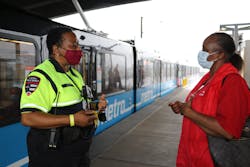Innovation in a Time of Uncertainty Leads to Quality Data and Enhanced Safety
The COVID-19 pandemic has forced the transit industry to face several setbacks, including budget cuts, ridership decreases and, in some cases, staff layoffs or furloughs. But perhaps a silver lining from this tumultuous time is the industry’s willingness to innovate and try new things at an uncommonly fast speed.
Agencies have been moving towards contactless fare collection before the coronavirus, such as St. Louis Metro Transit’s (Metro) mobile ticketing pilot program that was used for special events; New Jersey Transit’s (NJ Transit) mobile app used for trip planning and real-time information; and Washington Metropolitan Area Transit Authority’s (WMATA) SmarTrip® permanent, rechargeable card.
While the world grapples with understanding a “new norm,” agencies such as these have prioritized their efforts to ensure a safer, simpler and more convenient return for passengers by expanding their contactless fare collection solutions.
Speedy Innovation, Rapid Implementation
St. Louis Metro Executive Director Jessica Mefford-Miller explains mobile ticketing is something the agency has wanted to expand upon for several years.
“With COVID-19, it really created a sense of urgency...and a willingness as an organization to move faster and to try new things,” Mefford-Miller said.
St. Louis Metro had already been using the Transit app as its preferred app for trip planning, so potential vendors responding to the Request for Proposal (RFP) were required to not only have a validation process with the Transit app but also deliver a product within a matter of weeks. The solution, powered through Masabi’s Justride SDK, is visually validated mobile tickets that can be purchased in the Transit app. Metro is currently piloting three types of fares: MetroBus One-Ride, MetroLink One-Ride and Two-Hour Pass.
Mefford-Miller explains visual validation is just a temporary solution that needed to be implemented quickly because the agency resumed front-door boarding and fare collection on the Metro bus and light-rail system but temporarily suspended the issuance of paper transfers to limit the interaction between riders and operators.
“Because of our tight timeframe, I think it was three weeks from RFP to implementation, we really had to focus on what we wanted for this temporary solution,” she said. “Though our vendors I think are ready and willing to quickly expand and grow the program, we’re limited right now to what we've procured.”
That’s why St. Louis Metro is currently working on an RFP for a next generation, more permanent fare collection system, “but we are still embracing this momentum and desire to roll something out quickly,” Mefford-Miller added.
In an ideal world, Mefford-Miller says the agency wants a system with a mobile ticketing base, but incorporating that into an account-based system, with the overall goal of simplifying the fare structure and making it easier for customers to understand.
“Think of it as an account-based system with a smart card or mobile option,” Mefford-Miller said.
St. Louis Metro isn’t the only agency that experienced a rapid implementation. NJ Transit Chief Technology Officer Faisal Jameel shares the agency has “always” wanted to upgrade their devices used to validate tickets, whether they are mobile or paper tickets.
“I think it took a new meaning with COVID-19,” Jameel said. “We were forced into getting [these devices] implemented on a speedier schedule. It got accelerated by about six months to a year.”
At the beginning of July, NJ Transit started piloting handheld mobile validation devices on the Raritan Valley Line to offer a touchless experience for customers. The devices use an iPhone and have a scanner that attaches to the phones, which does the actual reading of a ticket. This required the agency to order 1,500 iPhones, about 1,500 scanners and develop the app that goes along with the devices. Lookman Fazal, NJ Transit chief information and digital officer, explains the agency didn’t want to do a mass rollout until one of the lines tested the devices, provided feedback and enhancements were made.
“Based on the feedback we received, we felt confident that we could then expand it to the Atlantic City line, which is already in place,” Fazal said. “And followed by the Morris and Essex Lines, which is about 50 percent complete.”
The agency is now tasked with training 100 conductors a week on how to use the devices. And as more start to use the devices, more feedback is received, allowing for more improvements to be made. One added suggestion led to the digitalization of the rulebook conductors carry on each trip.
“[Conductors] are very happy with it actually,” Jameel said. “The fact that [we’re] accommodating them by digitizing some of those documentations, they seem to love the device and look forward to using it.”
NJ Transit is also upgrading its fare collection technology on its buses to provide a contactless experience. The agency is putting what it calls an onboard validator on all 2,800 buses so that passengers scan their tickets instead of handing them to the bus operator or putting then in the box.
For WMATA, Cubic Transportation Systems (Cubic) President Jeff Lowinger explains a successful speedy rollout of SmarTrip for the iPhone and Apple Watch centered on building upon what was already there.
“The more you can use of existing versus creating a different experience, the quicker you can roll out,” Lowinger said.
Coincidentally, this was also one of the more challenging tasks: integrating the older technology into the newer technology.
“You have to take not only the existing cards that are there, but you have to be able to integrate with the user experience, with the hardware that's available today, that interacts with the watch and the wallet,” Lowinger explained.
In order to implement this new offering, WMATA and Cubic had to upgrade readers, validators, as well as look at one whole account back office to all be integrated into a solution set. But the biggest improvement, according to Lowinger, was the addition of the mobile app.
“Our traveler app has its own virtual capability, and it integrates also with the Apple Wallet,” Lowinger said. “That was really kind of the biggest challenge, or biggest improvement, is how we integrate our traveler app with the overall experience with the Apple wallet. There’s an Android Play coming soon, too.”
More Than Reducing Person-To-Person Contact
Eliminating touchpoints is an obvious benefit of contactless fare collection solutions. However, these apps, mobile tickets and handheld validation devices are part of the Mobility-as-a-Service (MaaS) journey thanks to their ability to streamline the customer experience and provide essential data to inform decision making.
For instance, St. Louis Metro is using data from the Transit app, as well as the fareboxes where mobile ticketing transactions are geo-located to help the agency understand where people are and are not using fare collection technologies.
“That’ll help us market it, that will help us better communicate and understand where we do or don’t have good penetration for any given product,” Mefford-Miller said.
But perhaps most importantly, St. Louis Metro’s use of the Transit app creates a seamless user experience with users able to plan, book and pay for their trip all in one platform, allowing people to take transit more spontaneously.
“And that’s what Mobility-as-a-Service is all about. It's making it easy and fast to plan, book and pay for your trip. And that’s where we’re headed,” Mefford-Miller said.
NJ Transit is also able to collect critical information from its handheld validation devices and analyze it to help with capacity, route optimization and scheduling. The data can show how full a particular train is at certain times, which is the most crowded car, which is the most crowded station and the capacity spread across the train or buses, allowing the agency to adjust service to prevent crowding, especially important to help prevent the spread of COVID-19. Thanks to this collection of data, NJ Transit recently launched a "How Full is Your Ride" feature on its mobile app, empowering customers to make informed decisions about when they're comfortable using the system. The information can also tell the agency how conductors are performing, such as how efficiently they’re collecting tickets.
“It gives us a little bit of insight as to the operations of [fare] collection,” Jameel explained.
“All those analytics and decision making make for a better customer experience,” Fazal added.
Lowinger echoes similar thoughts, reiterating riders want a single app for a more simplified journey, and they want information to help them make better decisions on how and when they will get to their destination.
“If we think about what people really want, [it is that] they want a predictable journey,” Lowinger said. “How do we bring in the right technologies that it provides rider confidence? I think the new norm is in front of us and it’s accelerating.”
Mefford-Miller agrees the acceleration of rolling out new technology is something that was unprecedented prior to COVID-19.
“We are moving, and I can’t emphasize this enough, we are moving so much more quickly than we have in the past. Whether it’s technology or policy, we are really trying to embrace what we’ve learned through COVID-19 and then the nimbleness [in which] we’re operating and carry that forward – even beyond the effects of the pandemic,” Mefford-Miller said.

Megan Perrero | Editor in Chief
Megan Perrero is a national award-winning B2B journalist and lover of all things transit. Currently, she is the Editor in Chief of Mass Transit magazine, where she develops and leads a multi-channel editorial strategy while reporting on the North American public transit industry.
Prior to her position with Mass Transit, Perrero was the senior communications and external relations specialist for the Shared-Use Mobility Center, where she was responsible for helping develop internal/external communications, plan the National Shared Mobility Summit and manage brand strategy and marketing campaigns.
Perrero serves as the board secretary for Latinos In Transit and is a member of the American Public Transportation Association Marketing and Communications Committee. She holds a bachelor’s degree in multimedia journalism with a concentration in magazine writing and a minor in public relations from Columbia College Chicago.


